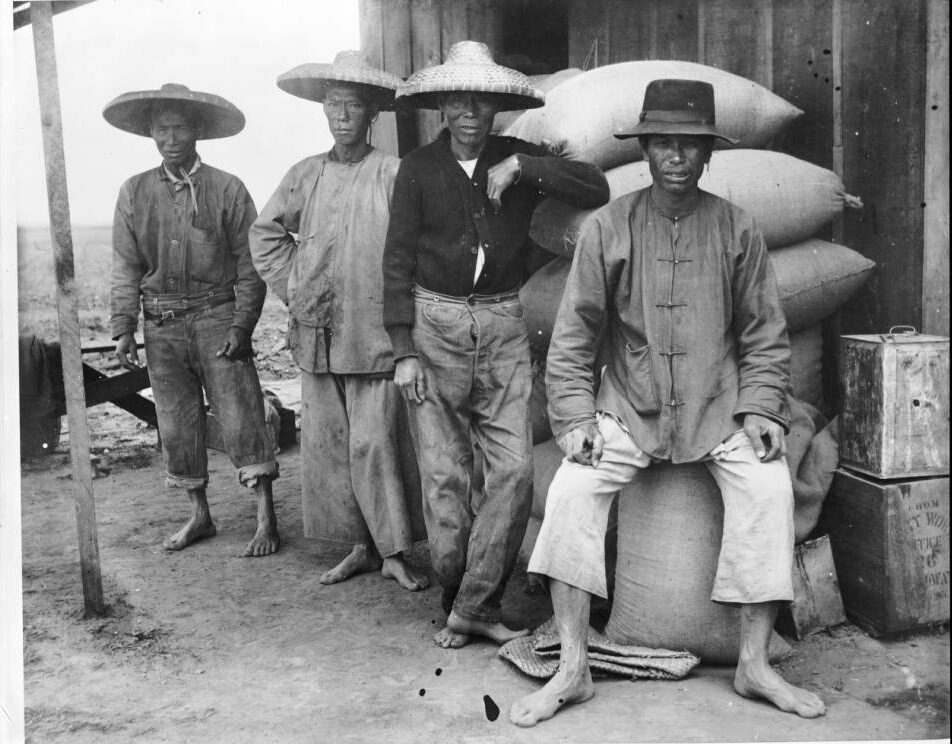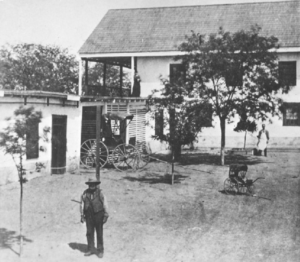Asian American and Pacific Islander Heritage Month (AAPI): How Chinese women were erased from history.

Four Chinese field hands standing near a building, c. 1898
For Asian American and Pacific Islander Month, we want to also acknowledge the Chinese women that are missing from our history. When talking about the past, it is important to acknowledge what is there but also what is missing and why. In 1872 when Rancho Los Cerritos was a working sheep ranch, Ah Ying and Ah Fan handled all the cooking and cleaning. They were Chinese immigrants who lived and worked in California without wives or families. This was a couple of years before the Chinese Exclusion Act, but there were already restrictions in place on Chinese women and children. One of those being the Page Act of 1875. All Chinese women during the 19th century were stereotyped as prostitutes and sex objects; therefore, this labeling justified the Page Act (Rotondi). Even though the prostitution of Chinese women was rampant in areas like San Francisco, most of the prostitution was forced onto these women. Groups known as the “tongs” used young Chinese girls and women to generate money. Some were sold to wealthy owners, some were placed in elite prostitution homes, and others ended up in bordellos for both poor white and Chinese men clientele (Yuan, 2019). In Los Angeles and San Francisco, women in these prostitution homes were treated horribly and many who were ill or sick were eventually alienated or discarded (Yuan, 2019). The number of Chinese women in California differed depending on how strong the sex trade was in each city. Eventually, the 1875 act and others prevented Chinese men from staying in the U.S. permanently as they would provide cheap labor and then return to China to reunite with their families. The Chinese exclusion act of 1882 further exacerbated this issue. This act went on from 1882 to 1943 when it was repealed. The act prevented skilled and unskilled Chinese workers from entering the U.S. due to increased racial sentiment, stereotypes, and economic factors in the West (Wu, 2021). No longer could Chinese workers freely enter and exit the U.S. As a history museum, we are entrusted with telling the stories of the entire community, especially those that have been historically excluded like the Chinese women who were separated from their families. By acknowledging this history, we can learn from history, understand the present, and shape a better future.

Ah Ying, a Chinese cook and laundryman, is seen in the background
If you’d like to learn more about Chinese contributions to shaping California, please view our exhibit; Building a New California: The Lives and Labor of Chinese Immigrants from 1850 to 1930.
AAPI Resources:
- Rancho Los Cerritos Exhibit: https://www.rancholoscerritos.org/building-a-new-california-the-lives-and-labor-of-chinese-immigrants-from-1850-to-1930/
- Korean Resource Center, virtual event: https://www.krcla.org/events/conversation-with-dr-claire
- Long Beach Public Library AAPI events: https://www.longbeach.gov/library/news/aapi-celebration/
- Asian Pacific American Heritage Month: https://asianpacificheritage.gov
- StopAAPIhate: https://stopaapihate.org
- ALL-AMERICAN: AAPI group show, in-person event: https://ktla.com/community-calendar-ktla/?/calendar/&EventID=7252119#!/details/ALL-AMERICAN-an-AAPI-group-show/9034865/2021-05-22T15
- AAPICovid-19Project: https://www.aapicovid19.org/resources
- 13 kids books that celebrate Asian American and Pacific Islander (AAPI) culture and heritage: https://readingpartners.org/blog/13-kids-books-aapi-culture/
References:
Rotondi, Jessica. “Before the Chinese Exclusion Act, This Anti-Immigrant Law Targeted Asian Women”. History.com. https://www.history.com/news/chinese-immigration-page-act-women

Leave a comment
You must be logged in to post a comment.